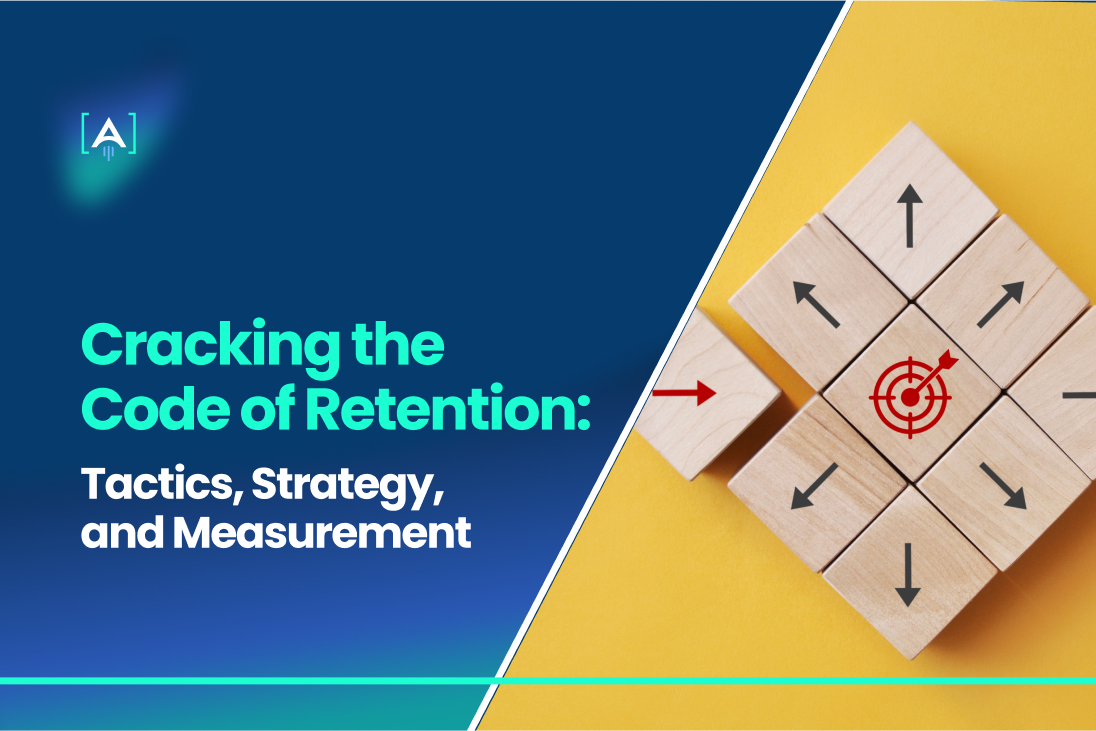Welcome aboard, startup enthusiasts!
Did you know that 44% of businesses fail to measure retention rates?
This means that all who fall into this group miss out on the opportunity to build a lifetime customer relationship.
After all, it’s worth building repeat business from loyal and existing customers rather than constantly going on the prowl to acquire new ones.
As you’re already here, you made the wise decision to focus on and measure your customer retention rate.
That’s awesome!

So today, we’re embarking on a thrilling journey into the heart of success in the ever-evolving business realm: retention.
It’s not just about acquiring new customers; it’s about keeping them hooked, happy, and longing for more of what you’ve got to offer.
So, fasten your seatbelts as we prepare to decode the secrets that will transform your startup into a customer magnet.
Let’s unlock the secrets together!
Understanding the Landscape of Customer Retention

Is it better to have your customers hanging on by a thread, or is it better to have them tethered strongly to your brand?
Let’s get into how customer acquisition and retention can be game-changers for you and how current trends have changed the startup landscape.
The Importance of Retention in Startup Growth
In the pulsating world of startups, understanding the paramount role of customer retention is akin to holding the keys to sustained growth.
As the titans of the startup realm continue to soar, a glance at the scoreboard reveals a staggering truth – the current top players boast an average customer retention rate of a whopping 94%.
This isn’t just a statistic; it’s the heartbeat of their success.
And in the startup game, it’s not just survival of the fittest but the retainers’ triumph.
Current Trends in Customer Retention
Personalization Revolution
Startups are increasingly tailoring experiences to individual preferences, with 90% of businesses recognizing content marketing as a cost-effective tool for retaining customers.
This trend involves offering curated product recommendations and personalized communications, ensuring a bespoke customer journey that goes beyond mere transactions.
Omnichannel Engagement
Breaking free from singular platforms, startups are creating seamless experiences across various channels such as social media, email, mobile apps, and in-app interactions.
Brands are strategically employing mobile apps and email marketing, with 44% and 52% of businesses utilizing these methods, respectively.
This interconnected web allows for diversified customer interaction and aligns with the current trend of using content to strengthen client bonds, enhancing continuity and customer loyalty.
Customer Service Chatbots
Recognizing the rising importance of instant support, customer service chatbots are becoming integral to the retention strategy.
As 89% of companies admit that excellent customer service is critical, chatbots play a crucial role in delivering real-time assistance, contributing to a positive customer experience.
Real-time Engagement
In the era of instant gratification, startups are prioritizing speed by leveraging advanced analytics and AI-driven tools, with the global AI market size expected to be worth $407 billion by 2027.
This monumental growth in AI underscores its pivotal role in anticipating customer needs and providing real-time engagement, including customer service chatbots. This aligns with the evolving role of content, where it is not just a lead generation tool but a key element in swift issue resolution and bolstering customer satisfaction.
These trends collectively highlight the dynamic nature of customer retention in the startup landscape.
By acknowledging the cost-effectiveness of content marketing and embracing these evolving strategies, startups innovate within their industries and solidify their positions as trusted companions on the customer’s journey.
Common Pitfalls in Retention Strategies
Navigating the terrain of customer retention can be treacherous, even for the savviest startups. Understanding and avoiding common pitfalls is crucial to keeping the ship afloat.
Here are some frequent missteps that can impede your retention strategy:
Overlooking Customer Feedback: One of the biggest blunders is neglecting the goldmine of insights embedded in customer feedback. Whether it’s constructive criticism or glowing praise, failing to heed the voice of your clientele can leave your strategy adrift.
Static Strategies in a Dynamic Landscape: The business landscape is ever-evolving, and so should your customer retention strategies. Sticking to a static plan without adapting to emerging trends or customer expectations risks rendering your approach obsolete.
Misaligned Expectations: A rift between what customers expect and what your startup delivers is a surefire way to lose their allegiance. Setting realistic expectations and consistently meeting or exceeding them is paramount in building lasting customer relationships.
Ignoring Data Analytics: In an era where data is king, overlooking the power of analytics can be detrimental. Customer behavior, preferences, and engagement metrics provide invaluable insights. Ignoring this data is akin to sailing blindfolded in a sea of missed opportunities.
Inadequate Communication: Effective communication is the anchor that prevents your customers from drifting away. Failing to keep your clientele informed about product updates and promotions or even expressing gratitude for their loyalty can create a void competitors are all too eager to fill.
Lack of Personalization: In an age where customers crave personalized experiences, a one-size-fits-all approach can be fatal. Failing to tailor interactions to individual preferences undermines the very essence of how to retain customers.
By steering clear of these pitfalls, startups can chart a course toward robust and sustainable customer retention strategies.
Building a Solid Retention Strategy

Crafting a robust retention strategy is the cornerstone of sustained success for startups.
This involves a meticulous approach, incorporating key elements to fortify customer loyalty and satisfaction.
Setting Clear Retention Goals:
You must define clear and measurable goals to improve customer retention. Establishing benchmarks such as customer retention rates, lifetime value, and churn rates provides a roadmap for progress.
Clear goals not only align the team’s efforts but also enable consistent evaluation and refinement of the retention strategy.
Creating a Customer-Centric Culture:

A customer-centric culture is the bedrock upon which successful retention strategies are built. This involves instilling a deep understanding of customer needs and preferences across all levels of the organization.
From frontline staff to leadership, everyone should be attuned to the customer experience, fostering a culture that prioritizes customer satisfaction and long-term relationships.
Leveraging Technology for Retention:
In the digital age, technology is a powerful ally in the quest for customer retention.
Implementing advanced analytics, artificial intelligence, and customer relationship management (CRM) systems enables startups to understand customer behavior, personalize interactions, and anticipate needs.
Technological integration streamlines processes, enhancing the overall customer experience and solidifying retention efforts.
By setting clear retention goals, cultivating a customer-centric culture, and leveraging cutting-edge technology, startups can construct a retention strategy that not only attracts customers but transforms them into loyal advocates.
Tactical Approaches to Boost Retention

In the intricate tapestry of retention strategy, tactical approaches serve as the threads that weave lasting connections with customers.
Here are a few key examples:
Personalizing Customer Interactions:
Take, for instance, a personalized recommendation system employed by an e-commerce startup.
By analyzing a customer’s browsing history and past purchases, the system suggests products tailored to their preferences.
This enhances the shopping experience and cultivates a sense of understanding and attentiveness, fostering a deeper connection between the customer and the brand.
Enhancing Customer Support and Service:
Consider a software startup prioritizing immediate response to customer queries through live chat support.
By offering real-time assistance, addressing concerns promptly, and going the extra mile to resolve issues, the company ensures customer satisfaction and showcases a commitment to exceptional service.
This level of support builds trust and strengthens the customer’s loyalty.
Implementing Loyalty and Rewards Programs:

Imagine a subscription-based service implementing a tiered loyalty program.
As customers engage more with the platform, they unlock exclusive benefits such as early access to new features, personalized content recommendations, and discounts on premium subscriptions.
Such programs incentivize continued engagement and make customers feel valued for their commitment.
As startups embark on the tactical frontiers of personalizing customer interactions, enhancing customer support and service, and implementing loyalty and rewards programs, they fortify their positions in the competitive arena.
Engagement Strategies for Customer Retention

Startups can enhance audience engagement through content marketing and leveraging social proof and testimonials. Building community relationships further strengthens this bond.
Utilizing Content Marketing:
Imagine a beauty and skincare startup that consistently shares expert tips, tutorial videos, and user-generated content showcasing the effectiveness of their products.
By providing valuable and relevant content, they educate their audience and establish a connection based on shared interests and beauty aspirations, creating a community around their brand.
Leveraging Social Proof and Testimonials:
Consider an online marketplace for handmade crafts that prominently displays customer reviews and testimonials alongside product listings.
By showcasing the satisfaction of previous buyers, the platform builds trust and credibility, influencing potential customers to make informed purchasing decisions based on the positive experiences of others.
Fostering Community and Building Relationships:

Look at the example of a travel app that hosts a virtual travel community. Users share their travel stories, exchange tips, and provide recommendations.
This community-building approach goes beyond the app’s functionality, creating a network of like-minded individuals who share a passion for exploration, enhancing the overall user experience.
These methods unlock the potential for a loyal, brand-advocating customer base.
Data-Driven Decision-Making for Retention

In the era of digital prowess, harnessing the power of data is paramount for startups aiming to sculpt airtight retention strategies.
Unveiling the nuances of analyzing customer behavior and feedback, tracking and measuring retention metrics, and utilizing predictive analytics, you can navigate the intricate waters of data-driven decision-making with finesse.
Let’s see how data fuses with retention strategies to bring it full circle!
Analyzing Customer Behavior and Feedback:
Imagine an e-commerce platform that meticulously analyzes customer behavior on its website. The platform gains insights into individual preferences by tracking the visited pages, time spent on each page, and products viewed.
Coupled with feedback gathered through surveys and reviews, you understand what customers do and why they do it, allowing for informed decision-making to enhance the overall customer experience.
Tracking and Measuring Retention Metrics:
Tracking and measuring key metrics is non-negotiable for startups committed to retention excellence.
Metrics such as Customer Lifetime Value (CLV), Churn Rate, and Net Promoter Score (NPS) provide a comprehensive view of retention health.
A software-as-a-service (SaaS) startup, for instance, closely monitors churn rates to identify potential pain points in its service and proactively addresses them, ensuring customer retention remains robust.
Utilizing Predictive Analytics:
Predictive analytics is the crystal ball of retention strategy. It involves leveraging historical data and advanced algorithms to forecast future customer behavior.
For instance, an online streaming service utilizes predictive analytics to anticipate the content preferences of its users. By understanding what users will watch next, the platform tailors recommendations, keeping customers engaged and enhancing long-term retention.
This approach informs real-time strategies and empowers you to anticipate and proactively address the evolving needs of your customer base.
Optimizing the Customer Journey for Retention

In the pursuit of sustained customer retention, the customer journey emerges as a pivotal framework that encompasses the entire spectrum of a customer’s interactions with a brand.
This journey is a narrative that unfolds from the initial point of awareness to post-purchase engagement, encapsulating every touchpoint and experience along the way.
Mapping and Understanding the Customer Journey:
Mapping the customer journey involves breaking down the entire experience into discernible stages, each marked by distinct customer actions and emotions.�
These stages typically include:
- Awareness: Customers discover the brand through marketing, advertising, or word-of-mouth.
- Acquisition: Customers show initial interest or take a specific action, like signing up.
- Activation: Customers have their first meaningful interaction with the product or service.
- Retention: Ongoing engagement where customers continue to use and interact with the brand.
- Revenue: The stage where customers make a purchase, contributing to the brand’s income.
- Referral: Satisfied customers recommend the brand, expanding its reach and influence.
Understanding the customer journey in its entirety allows startups to identify pain points, anticipate needs, and tailor their strategies to enhance the overall customer experience.
Enhancing Onboarding and Early Engagement:

The onboarding phase is a critical juncture where customers transition from interested observers to active users. Effective onboarding involves:
- Providing clear and concise guidance on product or service usage.
- Offering immediate value to showcase the benefits of the product.
- Ensuring a seamless and positive initial experience sets the tone for the journey.
Focusing on High-Value Customers:
Identifying high-value customers involves analyzing metrics such as:
- Customer Lifetime Value (CLV): The predicted total revenue a customer is expected to generate throughout their relationship with the brand.
- Purchase Frequency: How often a customer purchases within a given period.
- Advocacy: The likelihood of a customer recommending the brand to others.
By focusing efforts on high-value customers, you can tailor retention strategies to this segment, maximizing the impact of their initiatives and cultivating lasting loyalty.
Innovative Approaches to Retention

In the ever-evolving landscape of customer retention, embracing innovation becomes the hallmark of forward-thinking startups.
Delving into implementing AI and machine learning, exploring new channels and platforms, and adopting sustainable and ethical practices, you can forge ahead, revolutionizing your retention strategies with a progressive and conscientious mindset.
Implementing AI and Machine Learning:
Picture a subscription-based streaming service that employs AI algorithms to analyze user viewing patterns.
By understanding individual preferences, the service tailors content recommendations, creating a personalized and engaging experience.
AI and machine learning can enhance the customer’s journey and allow startups to anticipate evolving needs, making retention strategies responsive and anticipatory.
Exploring New Channels and Platforms:
Exploration is the heartbeat of innovation, and startups committed to retention excellence must continuously seek new channels and platforms to connect with their audience.
This involves:
- Market Research: Identifying emerging platforms and channels relevant to the target audience.
- Adaptability: Being agile and willing to experiment with new channels based on evolving customer behavior.
- Multichannel Engagement: Creating a seamless experience across diverse channels, such as social media, emerging apps, and evolving online platforms.
Exploring new channels and platforms is not a one-time endeavor but a dynamic process that aligns with the ever-changing landscape of customer preferences.
Sustainable and Ethical Practices:
Sustainability and ethics are no longer buzzwords but guiding principles that resonate with conscientious consumers. Sustainable and ethical practices involve:
- Eco-Friendly Initiatives: Implementing practices that reduce environmental impact, such as sustainable packaging or carbon-neutral operations.
- Transparency: Communicating openly about business practices, sourcing, and ethical considerations.
- Social Responsibility: Engaging in socially responsible initiatives, whether through community outreach, fair labor practices, or charitable partnerships.
For example, a fashion startup committed to sustainability might use recycled materials in its products, maintain transparency about sourcing, and contribute to social causes.
Such practices appeal to environmentally conscious consumers and promote a positive brand image, fostering long-term loyalty.
Scaling and Sustaining Growth Through Retention

In the dynamic realm of business growth, scaling and sustaining success hinge on innovative approaches to increase customer retention.
Let’s get into them!
Building Scalable Retention Strategies:
Scalable retention strategies can adapt and expand seamlessly as a business grows. This involves:
Automation: Implementing automated processes that can handle increasing customer interactions without compromising personalization. For instance, an e-commerce startup may automate personalized email campaigns based on customer behavior.
Segmentation: Categorizing customers into segments based on behavior, preferences, or demographics. Scalable strategies can then be applied to each segment individually, catering to diverse customer needs without overwhelming resources.
Predictive Analytics: Utilizing predictive analytics to forecast future customer behavior. This allows startups to proactively implement scalable strategies, such as personalized recommendations or targeted promotions, based on anticipated needs.
In essence, scalability in retention means efficiently and effectively managing increased demand and complexity as a startup grows.
Integrating Retention with Other Business Areas:
Retention is not a siloed endeavor but an integral component that harmonizes with various business areas. This involves:
Sales and Marketing: Aligning retention efforts with sales and marketing strategies ensures a cohesive customer experience. For example, a seamless transition from a marketing campaign to a personalized retention offer creates a unified customer journey.
Product Development: Feedback from customer interactions and retention initiatives can directly inform product development. Understanding customer needs and pain points guides the creation of products that resonate with the target audience.
Customer Support: Integrating retention with customer support ensures a consistent and positive experience throughout the customer journey. Timely and effective support enhances satisfaction and contributes to long-term retention.
By integrating retention seamlessly with these business areas, startups create a holistic approach that transcends isolated efforts, fostering a unified and comprehensive strategy.
Measuring and Demonstrating ROI:
Measuring retention efforts’ Return on Investment (ROI) is a crucial aspect of sustaining growth. This involves:
- Defining Key Metrics: Identifying and tracking key metrics such as Customer Lifetime Value (CLV), Churn Rate, and Net Promoter Score (NPS).
- Attribution Modeling: Understanding how various touchpoints contribute to customer retention and assigning an appropriate value to each interaction.
- Collect Customer Feedback: Utilizing customer feedback to measure satisfaction and sentiment provides qualitative insights into retention strategies’ effectiveness.
By meticulously measuring and demonstrating ROI, startups validate the impact of their retention strategies and pave the way for informed decision-making and continuous improvement.
In summary, scaling and sustaining growth through retention demand innovative strategies and a holistic approach that integrates seamlessly with various facets of the business.
Cultivating Customer Retention: The Final Note in Startup Success

Optimizing the customer journey, you’re fostering loyalty and creating brand advocates. Adaptability, innovation, and ethical practices, along with embracing technology and sustainable strategies, are key to long-term success.
Customer retention is a collaborative effort, integrating sales, marketing, product development, and support.
Success is measured not just in numbers but in the stories of loyal customers and the communities that form around your brand.
In the dynamic startup landscape, these retention strategies are a guide toward sustainable growth, helping forge lasting connections and a lasting legacy.

